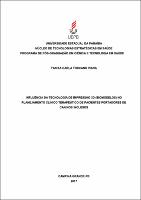| Compartilhamento |


|
Use este identificador para citar ou linkar para este item:
http://tede.bc.uepb.edu.br/jspui/handle/tede/2760Registro completo de metadados
| Campo DC | Valor | Idioma |
|---|---|---|
| dc.creator | Viana, Tanisa Carla Toscano | - |
| dc.creator.Lattes | http://lattes.cnpq.br/4904395505758279 | por |
| dc.contributor.advisor1 | Oliveira Neto, Jose Augusto de | - |
| dc.contributor.advisor1Lattes | http://lattes.cnpq.br/9814894825037581 | por |
| dc.contributor.advisor-co1 | Guedes, Maria Carolina Bandeira Macena | - |
| dc.contributor.referee1 | Brito, Nadja Maria da S. Oliveira | - |
| dc.contributor.referee2 | Grempel, Rafael Grotta | - |
| dc.contributor.referee2Lattes | http://lattes.cnpq.br/8073497946298578 | por |
| dc.date.accessioned | 2017-03-22T15:14:35Z | - |
| dc.date.issued | 2017-01-25 | - |
| dc.identifier.citation | VIANA, T. C. T. Influência da tecnologia de impressão 3D (biomodelos) no planejamento clínico terapêutico de pacientes portadores de caninos inclusos. 2017. 58f. Dissertação (Programa de Pós-Graduação Profissional em Ciência e Tecnologia em Saúde - PPGCTS) - Universidade Estadual da Paraíba, Campina Grande, 2017. | por |
| dc.identifier.uri | http://tede.bc.uepb.edu.br/tede/jspui/handle/tede/2760 | - |
| dc.description.resumo | Diversos fatores podem dificultar a correta erupção dos caninos, levando a impacção, porém, devido à sua importância, há um grande interesse em realizar o seu tracionamento, contudo diagnósticos e planos de tratamento imprecisos baseados em imagens 2D têm sido responsáveis por insucessos relatados na literatura. Diante desse contexto este trabalho teve por objetivo investigar a influência da tecnologia de impressão 3D (biomodelo), imagem 3D no planejamento clínico de caninos inclusos. A amostra foi composta por ortodontistas inscritos no CRO-PB que responderam a dois questionários, sendo o primeiro respondido após avaliar um caso clinico de caninos inclusos através de exames radiográficos e o segundo após analisar o mesmo caso clínico apenas com o biomodelo. O estudo mostrou que o biomodelo influenciou positivamente mudando o prognóstico e plano de tratamento, sendo que 98,3% dos participantes da pesquisa afirmaram que o biomodelo ajudou a esclarecer melhor o caso e 96,7% disseram que o biomodelo trouxe mais segurança na indicação do plano de tratamento. | por |
| dc.description.abstract | Several factors may hinder the correct eruption of the canines, leading to impaction, however, due to their importance, there is a great interest in carrying out their traction, however, inaccurate diagnosis and treatment plans based on 2D images have been responsible for failures reported in the literature . This work investigated the influence of the biomodel in the clinical planning of canines included, through two questionnaires answered by orthodontists, the first one after evaluating a clinical case of included canines through radiographic examinations and the other after analyzing the same clinical case through the biomodel image 3D. The study included orthodontists registered in the CRO-PB, 75% female, 51.7% aged 40 years or less, with a dental degree of 15 years or less (53.4%) and time Postgraduate course of 8 years or less (57.6%). 98.3% answered that the presented biomodel helped to clarify the case better, 96.7% answered that the biomodel brings more safety in the indication of treatment, we did not find statistically significant differences between the two situations regarding the degree of difficulty of the case, in Significant differences were observed between the prognosis of the presented case when comparing the responses of the participants without and with the use of biomodels, regarding the treatment option there were no significant changes when presenting the biomodel, however this change is observed when the question is asked about the Direction of traction. It was concluded that the biomodel provided a better clarification of the case and more safety at the time of indicating the treatment plan, as well as may influence the prognosis and initial direction in the cases of traction, however there were no significant changes in the type of treatment indicated to the case Nor in the degree of difficulty. | eng |
| dc.description.provenance | Submitted by Jean Medeiros (jeanletras@uepb.edu.br) on 2017-03-22T14:01:49Z No. of bitstreams: 1 PDF - Tanisa Carla Toscano Viana.pdf: 12346895 bytes, checksum: fe10348e684cc31cbfbc93ec862d8fda (MD5) | eng |
| dc.description.provenance | Approved for entry into archive by Secta BC (secta.csu.bc@uepb.edu.br) on 2017-03-22T15:14:35Z (GMT) No. of bitstreams: 1 PDF - Tanisa Carla Toscano Viana.pdf: 12346895 bytes, checksum: fe10348e684cc31cbfbc93ec862d8fda (MD5) | eng |
| dc.description.provenance | Made available in DSpace on 2017-03-22T15:14:35Z (GMT). No. of bitstreams: 1 PDF - Tanisa Carla Toscano Viana.pdf: 12346895 bytes, checksum: fe10348e684cc31cbfbc93ec862d8fda (MD5) Previous issue date: 2017-01-25 | eng |
| dc.format | application/pdf | * |
| dc.thumbnail.url | http://tede.bc.uepb.edu.br/jspui/retrieve/6051/PDF%20-%20Tanisa%20Carla%20Toscano%20Viana.pdf.jpg | * |
| dc.language | por | por |
| dc.publisher | Universidade Estadual da Paraíba | por |
| dc.publisher.department | Pró-Reitoria de Pós-Graduação e Pesquisa - PRPGP | por |
| dc.publisher.country | Brasil | por |
| dc.publisher.initials | UEPB | por |
| dc.publisher.program | Programa de Pós-Graduação Profissional em Ciência e Tecnologia em Saúde - PPGCTS | por |
| dc.rights | Acesso Aberto | por |
| dc.subject | Dente canino | por |
| dc.subject | Odontologia | por |
| dc.subject | Tomografia computadorizada de feixe cônico | por |
| dc.subject | Impressão tridimencional | por |
| dc.subject | Diagnóstico por imagem | por |
| dc.subject.cnpq | CIENCIAS DA SAUDE::MEDICINA | por |
| dc.title | Influência da tecnologia de impressão 3D (biomodelos) no planejamento clínico terapêutico de pacientes portadores de caninos inclusos | por |
| dc.type | Dissertação | por |
| Aparece nas coleções: | PPGCTS - Dissertações | |
Arquivos associados a este item:
| Arquivo | Descrição | Tamanho | Formato | |
|---|---|---|---|---|
| PDF - Tanisa Carla Toscano Viana.pdf | PDF - Tanisa Carla Toscano Viana | 12.06 MB | Adobe PDF |  Baixar/Abrir Pré-Visualizar |
Os itens no repositório estão protegidos por copyright, com todos os direitos reservados, salvo quando é indicado o contrário.




